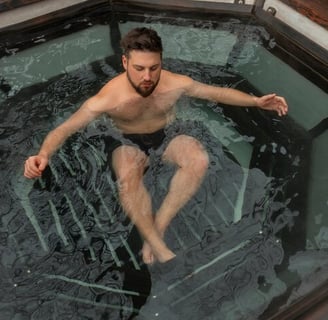The Benefits and Basics of Ice Baths for Recovery
Ice baths, also known as cold-water immersion, have become a popular recovery tool among athletes and fitness enthusiasts. This article explores the science-backed benefits of ice baths, how they work, and tips for safely incorporating them into your recovery routine.
MEN & WOMEN
11/13/20243 min read


Introduction to Ice Baths
Ice baths, or cold-water immersion therapy, involve submerging the body in cold water (typically around 10–15°C or 50–59°F) for several minutes. Commonly used by athletes to aid muscle recovery and reduce inflammation, ice baths have grown in popularity for their supposed ability to help both physical and mental recovery after strenuous activities.
How Ice Baths Work
The principle behind ice baths is relatively simple: the cold constricts blood vessels, which can help reduce inflammation and flush out metabolic waste products from exercise. When you exit the cold bath, your blood vessels dilate, bringing oxygenated blood back to your muscles, helping to speed up the recovery process.
The temperature drop also causes the body to release norepinephrine, a hormone that can help alleviate inflammation and even improve mood. This combination of physiological responses can result in reduced soreness, quicker muscle recovery, and enhanced mental clarity.
Benefits of Ice Baths
Reduces Muscle Soreness and Inflammation
One of the primary benefits of ice baths is the reduction of delayed onset muscle soreness (DOMS), which often occurs after intense exercise. Cold exposure can reduce inflammation, which speeds up the healing process for muscles that were heavily engaged during training.Aids Muscle Recovery
By flushing metabolic waste from the muscles and promoting blood flow, ice baths can help your muscles recover faster. This is especially helpful for athletes or fitness enthusiasts who need to get back to training soon after a challenging workout.Enhances Mental Resilience
Stepping into an ice bath is no small feat, and the process requires mental toughness. Many users report feeling a boost in mental clarity and resilience after regular cold immersion. The ability to endure discomfort may also translate to greater mental strength in other areas of life.Boosts Circulation and Immune Function
Alternating between cold and warm exposure, as in contrast therapy (which often follows an ice bath with a hot shower), can stimulate circulation and benefit cardiovascular health. Some studies also suggest that regular cold exposure can slightly enhance immune function.
How to Take an Ice Bath Safely
While ice baths are generally safe when approached correctly, there are a few guidelines to ensure a positive experience:
Set the Right Temperature
Aim for a water temperature between 10–15°C (50–59°F). Water that's too cold can cause extreme discomfort or even shock, while warmer water may not have the same recovery benefits.Limit Your Time
Start with 5–10 minutes in the ice bath and gradually increase time as you get more comfortable. For most people, 10–15 minutes is sufficient to gain the benefits without overstaying.Prepare Mentally
Breathing techniques, like deep breaths or focusing on exhalation, can help you relax. The initial shock of cold water can be overwhelming, but steady breathing will help you settle in.Follow with a Warm Shower
After your ice bath, take a warm shower to help gradually bring your body temperature back to normal. Avoid extremely hot showers right after, as the sudden contrast may strain your blood vessels.
Precautions
Consult a Doctor if you have cardiovascular issues or circulatory problems before trying ice baths.
Listen to Your Body – if the cold feels too intense or you feel numbness, it’s best to stop and warm up gradually.
Not for Everyone – while ice baths can be beneficial, they aren’t necessary for every workout recovery. Listen to your body’s needs and see what works best for you.
Conclusion
Ice baths can be a valuable tool for anyone looking to improve recovery time, reduce muscle soreness, and enhance mental resilience. Whether you’re an elite athlete or a fitness enthusiast, experimenting with cold-water immersion might just give you the edge you’re looking for. Remember to ease into the process, listen to your body, and consult a healthcare professional if you have any health concerns. With proper technique and a focus on safety, ice baths can provide a refreshing addition to your recovery routine.
Follow us on social media
Explore fitness articles and personal training options.
Fitness Jobs
© 2024. All rights reserved.
